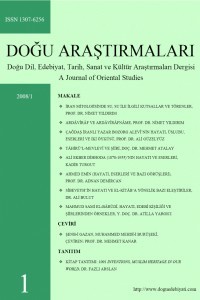STUDY OF GHURIDS SITUATION IN SULTAN MOHAMMAD KHWAREZM SHAH PERIOD
.
STUDY OF GHURIDS SITUATION IN SULTAN MOHAMMAD KHWAREZM SHAH PERIOD
The Ghurids, Khwarezmian, Sultan Mohammad, battle Sultan Ghias al-Din Ghurid.,
___
- 1. Ostokheri, Abu Eshagh Ebrahim. (1994). Al-Masalek, Al-Mamalek (Policies and States). Tehran. Translated by Mohammad Ibn As‟ad Ibn Abdollah Testeri. Iraj Afshar(ed.). Charity Institude of Dr. Mahmoud Afshar.
- 2. Ibn Asir, Ezzeddin Ali, Bi Ta. (1994). Alcamel (History of Islam and Iran).Tehran. Translated by Abul Ghasem Halat. Moasseseye Matboate Elmi Publication.
- 3. Ibn Khaldoon, Abdol Rahman. (2004). Alabr (History of Ibn Khaldoon). Volume
- 4. Tehran. Translated by Abdol Mohammad Ayati. Research Center for Human Sciences and Cultural Studies. 4. Ibn Esfandiyar, Baha al-Din Mohammad Ibn Hassan. (1987). Tarikhe Tabarestan (History of Ancient Hycania). Tehran. Abbas Eghbal(ed.).Khawar Publication.
- 5. Baghdadi, Baha al-Din Mohammad Ibn Moayyed. (1936). Al-Tavassol Ela AlTarassol. Tehran. Ahmad Bahmanyar(ed.). Sherkate Sahami Chap Publication.
- 6. Barthold, Wasili Veladimirovich (1987). Turkestan Nameh (About Turkestan). Tehran. Translated by Karim Keshavarz. Agah Publication. 2nd Edition.
- 7. Bath Worth, Clifford et al (2002). History of Iran (from Seljuks to Decline of Ilkhanids). Tehran. Translated by Hassan Anousheh. Volume 5. Amirkabir Publication. 5th edition.
- 8. Jozjani Menhaj Seraj. (1984). Tabaghate Nasseri (Classes of Nasseri)Tehran. Abdolhay Habibi(ed.). Donyaye Ketab Publication.
- 9. Joveini, Ata Malek. (1996). Tarikhe Jahangoshai (History of World conquerors). Tehran. Mohammad Ghazvini(ed.). Donyaye Ketab Publication.
- 10. Habibi, Abdolhay (1988). History of Afghanistan after Islam. Tehran. Donyaye Ketab Publication.
- 11. Khandmir, Ghias al-Din Ibn Homam al-Din. (1984). Tarikhe Habib Alseir Fi Akhbar Afrad-e-Bashar. Tehran. Under the Supervision of Mohammad Dabir Siaghi. Khayyam Publication.
- 12. Roshan Zamir, Mehdi. (2537). The Political and Military history of the Ghurids dynasty. Tehran. Iran National University.
- 13. Zarrinkoob, Abdol Hossein. (2004).About Past Literature of Iran. Tehran. Sokhan Publication.
- 14. Shabankarei, Mohammad Ibn Ali. (1984). Majmao al-Ansab. Tehran. Mir Hashem Mohaddes(ed.). Amirkabir Publication.
- 15. Aroozi Samarghandi, Ahmad Ibn Omar. (1990). Chahar Maghaleh (Four Articles).Tehran. Mohammad Ghazvini(ed.). Amirkabir Publication.
- 16. Foroughi Abri, Asghar. (2002). History of the Ghurids. Tehran. Samt Publication.
- 17. Unknown (1987). Malek al-Shoara Bahar. Tehran. Padideh Publication.
- 18. Lin Pol, Stanly. (1984).The Classes of Islam Sultans. Tehran. Translated by Abbas Eghbal. Donyaye Ketab Publication.
- 19. Mostoufi Ghazvini, Hamdollah Ibn Aboubakr Ibn Mohammad Ibn Nasr. (1957). Nazhat al-Gholoob. Tehran. Mohammad Dabir Siaghi(ed.). Tahoori Publication.
- 20. --------. (1998). Zafar Nameh (Book of Victory). Tehran. Nasrollah Pour Javadi(ed.). Markaze Nashr Daneshgahi Publication.
- 21. Mirkhand, Mohammad Ibn Khavand Shah. (1960). Tarikh-e- Rozat al-Safa. Tehran. Khayyam Publication.
- 22. Yaghoubi, Ahmad Ibn Abi Yaghoub. (2002). Al-baladan (The Cities). Tehran. Translated by Mohammad Ebrahim Ayati. Elmi va Farhangi Publication.
- ISSN: 1307-6256
- Yayın Aralığı: Yılda 2 Sayı
- Başlangıç: 2008
- Yayıncı: Ali GÜZELYÜZ
ESKİ UYGUR TÜRKLERİNDE TERCÜME FAALİYETLERİ HAKKINDA KISA BİR ARAŞTIRMA
GELİBOLULU ÂLÎ’NİN MECMAU’L-BAHREYN ADLI ESERİ
MODERN SURİYE HİKÂYESİNE GENEL BİR BAKIŞ
THE IRANIAN INFLUENCE INTO THE TURKISH MYTHS OF ANCESTOR FOUNDER
MUHAMMED İKBAL’İN İCTİHAD ÜZERİNE GÖRÜŞLERİ
HINDI STYLE AND ITS REFLECTION OF OTTOMAN TURKISH POETRY
FARS EDEBİYATINDA TEZKİRE YAZICILIĞI VE EDEBİYAT ELEŞTİRİSİ* MAHMUD FUTÛHÎ
RESMİ DİL URDU: MUHALEFETİN TARİHÇESİ* SEYYİD İŞFAK HUSEYİN BUHARİ
